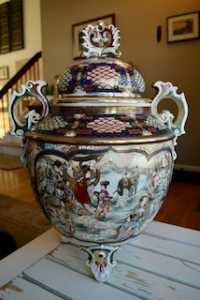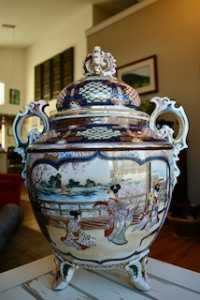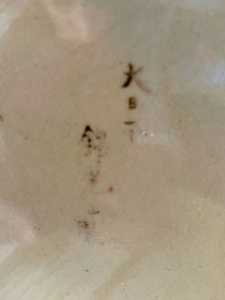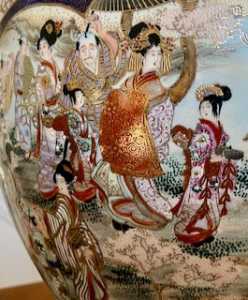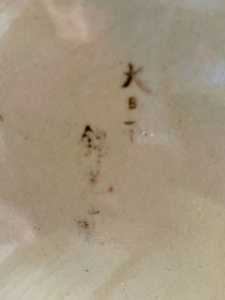The Chinese and Asian Art Forum. For Fans, Collectors and Dealers.
 Basic Rules For the BidAmount Asian Art Forum: Talk about whatever you want. You can even discuss and offer things that are for sale if they are authentic. Maximum image file size per post is 2 MB. Images of 700pxl x 700pxl are optimal if saved at a medium resolution. Be respectful of others and enjoy yourself. Click the YouTube link for a brief tutorial on using the forum. You can also EMBED Videos by cutting and pasting from You-Tube, Vimeo etc.
Basic Rules For the BidAmount Asian Art Forum: Talk about whatever you want. You can even discuss and offer things that are for sale if they are authentic. Maximum image file size per post is 2 MB. Images of 700pxl x 700pxl are optimal if saved at a medium resolution. Be respectful of others and enjoy yourself. Click the YouTube link for a brief tutorial on using the forum. You can also EMBED Videos by cutting and pasting from You-Tube, Vimeo etc.
NOTE: To post an item or add a new post, click open the category title from the FORUM LIST, and CLICK the Blue ADD TOPIC button.
I am having trouble finding anything like this Meji-era, large, 13-pound, 18" tall by 13" wide Satsuma pot/jar/koro made by Kinkozan per the authentication mark. I know that there are large, tri-pod, lidded, pots out there that are often called Koro and usually have lions for handles and lid tops; however, this one is distinctly different in shape and is hefty. The drawings, for sure, match some of the artwork found in Kinkozan earthenware.
Has anyone seen anything comparable to this? Thanks, guys.
Hi,
Welcome to the forum! Your pot looks interesting, but unfortunately I can't get your photos to enlarge.
Hopefully someone else will be able to help you soon. If not, I will try again later on a different device.
Julia
@julia does this work?
You click on the image and it takes you to an album stored at imgbb cloud hosting.
Yes, thank you, that works fine.
I can't see enough of the mark to make out more than the top three characters, but I am not sure about it. As you mention it is a little unusual in style, but not everything the studio turned out was of the top artistic quality.
To be honest, it seems a little lacking in elegance compared to the really good pieces. That is just my opinion, others may well disagree, but I feel I need to look more into it and certainly I need to view the pictures on a bigger screen than the one I am now on.
In the meantime, maybe someone else will be able to help better. Do you have any photos of the whole base?
There are a few pieces to compare the style in this sale, I imagine you already have of course, but others may find them useful - and they are nice to look at.
Julia
Interesting. Thanks for your reply.
Someone else I consulted who inspected photos and helped me figure out the mark has little doubt that it is Kinkozan and that the size is huge, but not uncommon. My understanding from him is that there is a wide range of quality and style in Kinkozan ware. He speculates it might have been produced as a limited edition. However, I'm putting out feelers to see if there is anything similar out there. I think I understand what you mean by it not being 'elegant,' Although it is stunning in person, it is not of the refined ilk that you see posted a lot online at higher-end auction houses. His observation was that "it is a very beautiful piece, well painted by a very skilled painter (or several painters, with their own specialization for the border decoration and the actual images). The style of painting is a bit looser than with other Kinkozans, but that is part of the style. It was certainly not done 'sloppy', you often see that with pieces of lesser quality. This was certainly not cheap in its day and intended for a group that could afford it, living in a house where you can display larger items. The appreciation for this type and style of Satsuma is on the moment perhaps less than for the very refined Kinkozans, but that does not detract from the quality."
I have uploaded a photo of the base to this link as the quality of the image is better that way:
The third vase in the link you kindly provided (thanks) evokes the artistry and borders seen on my piece. The first two don't.
Hi blu,
Your item is a very unusual looking piece. It's highly detailed and of good quality. I believe it's from the late Meiji period 1868-1912 through to the Taisho period 1912-1926. So circa 1900-1920 imo.
As noted kinkozan pieces are of various qualities and artists. At their peak they had thousands of artists working for them.
However imo the quality stated to deteriorate after about 1920.
Unfortunately I can't read or speak Japanese. So I can't help you with the partial mark.
At first glance I would have thought that it was unlikely to be kinkozan. But after a more in depth look...... it's possible.
Perhaps ask my friend Martin what he thinks about it.
Mark
@imperialfinegems thanks for your reply.
Yeah, I know what you mean about it being an unusual piece. I think that is why I am searching so much for as much information as I can find on it. I am thinking of selling it, and if I do, I want the description to be accurate. Although, I am also sorely tempted to just keep it. I got this piece for a steal at a local auction. It was dirty and dusty and you couldn't tell that it was very old as - how many pieces do you usually see of this shape and heft of that vintage? It is usually narrower tall vases and smaller incense burners.
It has the Dai Nippon mark classic of the Meiji period. That's a solid.
大日本 (made in Japan)
This is the kanji that the second-to-the-left column of kanji appears to be per the person I consulted:
錦光山(Kinkozan)製(Sei/made by)
I will follow up with Martin.
Thanks for the extra photos. The base is good. What I notice most is the almost 3 dimensional quality to parts of it, ie the gold and the white edges are quite raised which makes me think a little later than Meiji, so basically more likely Taisho as Mark suggests.
@julia thanks. Yes, there are raised dots and lush gold highlights on the two main scenes. Good point. I will have a look through examples from the Taisho period.
I am also looking at the stamp and if it fits the Taisho period. Per Gotheberg, "It is generally accepted that marks that include "Dai Nippon" in Japanese characters on the whole date to the Meiji (1868-1912) period, reflecting the greatly increased nationalism of that period. However, in stamped versions it also occurred on mass produced export wares well into the 1930s." The mark on mine is hand-painted in gold.
It could well be late Meiji, I am a bit stumped by the style and the quite fussy decoration. I am thinking 1910 to 1920 ish because for me, and I can't stress that enough ( 😊 ), some of the decoration makes me think of the "faces" vases that have all the brown background and heavy gold lines or even the moriage dragonware.
However, as there are so many Kinkozan studio pieces, age is a to a degree irrelevant in comparison to quality and desirability: the style of yours is unusual which may interest collectors and it is a decent size.
I imagine you have looked at the satsuma-database.nl site? If not there is a good link to it in another thread on satsuma. That may help you further. I don't have the expertise to offer more than a personal opinion but on that site I think you can pay for an assessment which may be worth doing simply because your item is a little unusual.
@julia thanks so much for your interest and thoughts. I will be sure to post here with whatever I learn. That website is a wealth of valuable information. Stumped is a good word, lol. It is gorgeous, whatever it is.
You are very welcome and please keep us informed of what you find!
@julia it looks like the piece is likely, Meiji-era, pre-1909:
"While the terms Edo, Meiji, or Taisho are historically well-defined periods, the same is not true of the distinction in art styles. In these, there is constant development and something made in 1912 (meiji) is actually indistinguishable from the same work made in 1913 (taisho). The same applies to the term Dai Nippon, which was often used during the Meiji period, but also to a decreasing extent afterwards. And sometimes much later, to suggest an earlier time. I don't think this applies to Kinkozan, and that Dai Nippon in this case was indeed done sometime during the Meiji period, at the height of Japanese nationalism. Incidentally, he used Nippon in kanji's much more frequently, also in the Meiji period, and from 1890 (because of exports to the US) also the term Nippon (and from 1920 Japan) in Roman script. The latter always stamped, western text was never handwritten. However, it was usually printed on a piece of paper with Kinkozan-Kyoto, but since that is often lost, there is also a lot of work with no mention of the country. The raised points and thick gold accents as you mentioned are certainly not good indicators of the Taisho period, both were used much earlier. The handwritten manner of the signature means that he did not use the well-known Kinkozan logo written in a square, which was registered in 1909 and used (stamped or painted) afterwards. This makes it likely that the sign was written in earlier years. The type of pot looks rather Victorian, but the colors are light and especially the purple seems of a later date (according to some people). However, Kinkozan used and experimented with a variety of colors as early as the 19th century. I think it is impossible to determine exactly when this pot was made, but late 19th century or early 20th century, (i.e. Meiji period) would be a good indication as far as I am concerned. But in the end, that doesn't matter much, and quality is always the best way to look at Satsuma."
Well, that is interesting! At least we agree on the quality being the important issue. To be fair, I did note the slight victorian look and indeed entertained a fleeting thought about it being made for export in France in 1890s, but dismissed it because I felt the moriage was too much - maybe I was too hasty! 😊
Obviously, styles don't change over night when one period ends and another begins, those are just guidelines and moriage did indeed exist earlier - I once had a lovely art nouveau vase but it was more subtle. Still my feelings that it could be Taisho will have have to acknowledge what was said about the way the signature was done. I might wonder about other things, but I don't know enough about the signatures to even start contradicting that!
In fact, I am going to copy that for future reference, it was a very helpful, response thank you so much for sharing it. If you sell it, I would be very interested to know how it does.
ps, I also copied a couple of your pictures to file with it, hope that is ok?
Thanks for visiting "The BidAmount Asian Art Forum | Chinese Art"
If you sell on eBay, or have a shop feel free to post images and descriptions and links.
Check back often for discussion about the latest news in the Chinese art and antique world. Also find out about the latest Asian art auctions at Sotheby's, Christie's, Bonhams and Tajans.
Auction results for: fine porcelain, ceramics, bronze, jade, textiles and scholar's objects. As well as Japanese, Thai, Vietnamese and other Asian cultures.
Thank you,
Peter Combs
Topics and categories on The BidAmount Asian Art Forum | Chinese Art
Kangxi vases, Kangxi dishes and chargers, Kangxi ritual pieces, Kangxi scholar's objects, Qianlong famille rose, Qianlong enamels, Qianlong period paintings, Qianlong Emporer's court, Fine porcelain of the Yongzheng period. Chinese imperial art, Ming porcelain including Jiajing, Wanli, Xuande, Chenghua as well as Ming jades and bronzes.
The BidAmount Asian Art Forum | Chinese Art
A free Asian art discussion board and Asian art message board for dealers and collectors of art and antiques from China, Japan, Korea, Thailand, Cambodia, Vietnam and the rest of Asia. Linked to all of the BidAmount Asian art reference areas, with videos from plcombs Asian Art and Bidamount on YouTube. Sign up also for the weekly BidAmount newsletter and catalogs of active eBay listing of Chinese porcelain, bronze, jades, robes, and paintings.
The art of calligraphy - and for the ancient Chinese it certainly was an art - aimed to demonstrate superior control and skill using brush and ink. Calligraphy established itself as one of the major Chinese art forms during the Han dynasty (206 BCE - 220 CE), and for two millennia after, all educated men were expected to be proficient at it.
The Museum’s collections of Asian art span nearly five millennia and encompass the cultures of China, the Himalayas, India, Japan, Korea, and Southeast Asia. In 2007, the Museum launched an initiative to create dedicated galleries for the collection, beginning with a gallery for the arts of Korea ...
Chinese art is full of symbolism, in that artists typically seek to depict some aspect of a totality of which they are intuitively aware.
China Online Museum is the finest online museum of Chinese art. It features Chinese calligraphy, painting, ceramics, bronzes, carving, and other artworks.
Chinese Ceramics & Works of Art. Overview Upcoming auctions Contacts Auction results ... Christie’s sales of Chinese ceramics and works of art showcase centuries of Chinese history. Held throughout the year in London, New York, Paris and Hong Kong, they attract a wide audience of collectors and connoisseurs vying for pieces as diverse as ...
Explore Asian Art Week. Contact the Specialist Department. Chinese Paintings ... Senior Specialist, Head of Sale. [email protected]. Tel:+1 212 641 5760. Bid in-person or online for the upcoming auction:Fine Chinese Paintings on 10 September 2019 at New York. Bid in-person or online for the upcoming auction:Fine Chinese Paintings on 10 ...
Discover an abundance of must-see art from all corners of a vast continent at Christie’s NY Asian Art Week. From contemporary classical and Chinese paintings to works with exemplary provenance from the Art Institute of Chicago, our Rockefeller Paza galleries will be full of ancient treasures and contemporary masterworks in a salute to the vibrant arts of Asia.
Sold to benefit The Art Institute of Chicago’s Asian Art Acquisition Fund, the sale features 84 lots with a focus on Ming and Qing porcelains, and offers a rare insight into the taste for collecting Chinese ceramics and works of art in the Midwest from the end of the 19th century through the 1980s. Highlights include two Wanli wucai garlic-head vases, a Qianlong mark and period, blue and ...
Specialist, Chinese Paintings, Christie's London Dr Malcolm McNeill is a Specialist in Chinese Paintings at Christie’s, based in London. He previously worked as an assistant curator of the Chinese collections and the Victoria and Albert Museum in London, as a researcher at the British Museum, and as a translator and tour guide at the National Palace Museum in Taipei.
The Christie's Education 2020 Conference: The Chinese Art Market 18 Jun 2019 Christie’s Education is delighted to announce our first international academic conference in Asia which will take place in Hong Kong from 26-27 November 2020 at the Hong Kong Convention and Exhibition Centre and will run in parallel with Christie’s Hong Kong Autumn Auctions.
The summer Chinese Art sale in Hong Kong will feature works of art from several private collections, including Qing porcelains and textile from the collection of the legendary Chinese art dealer A. W. Bahr (1877–1959), fine gilt bronze Buddhist sculptures from an old Hong Kong collection, an East Asian collection of Qing dynasty wine cups and jades, and a Japanese collection of Song ceramics ...
Sotheby's Chinese Works of Art Department holds two auctions each year in London, New York, Hong Kong and Paris.
Chinese Art - View Auction details, bid, buy and collect the various artworks at Sothebys Art Auction House.
With more than 340 Chinese works of art dating from the Neolithic to the Republic periods, highlights of this sale include a selection of Qing Imperial monochromes from the collection of Arnold and Blema Steinberg, early ceramics from the Art Institute of Chicago and Chinese porcelain and works of art from the collection of Henry Arnhold.
Results: Sotheby's Asia Week achieved $52.4 million in six strong auctions, exceeding pre-sale estimates. With 76.5% of lots sold and 60.3% of lots surpassing high estimates, the Asian art sales at Sotheby's indicate continued collector interest in the finest works of art from China, India and and the Himalayas.
Today's sale of Important Chinese Art will proceed as planned with sessions at 10 AM and 2 PM EDT. Sotheby's will be monitoring the weather conditions throughout the day and will be available to coordinate alternative bidding options should conditions make it difficult for clients to attend the auction in person.
Bonhams Chinese Art department is renowned for offering the finest works of art representing the richness and breadth of China's artistic heritage, particularly Imperial porcelain, white and spinach green jades, cloisonné and Buddhist art. Specialised international auctions are held globally, including London, Hong Kong and San Francisco.
Bonhams : Chinese Works of Art We use cookies to remember choices you make on functionality and personal features to enhance your experience to our site. By continuing to use our site you consent to the use of cookies. Please refer to our privacy and cookie policies for more information.
Bonhams Fine Art Auctioneers & Valuers: auctioneers of art, pictures, collectables and motor cars. We use cookies to remember choices you make on functionality and personal features to enhance your experience to our site. By continuing to use our site you consent to the use of cookies. ... Chinese Art (US) General enquiries
Bonhams : Fine Chinese Art We use cookies to remember choices you make on functionality and personal features to enhance your experience to our site. By continuing to use our site you consent to the use of cookies. Please refer to our privacy and cookie policies for more information.
Bonhams Fine Art Auctioneers & Valuers: auctioneers of art, pictures, collectables and motor cars Bonhams : Asian Art We use cookies to remember choices you make on functionality and personal features to enhance your experience to our site.
Bonhams are international auctioneers of fine Chinese and Japanese art. We specialise in rare Imperial and Export Chinese ceramics and works of art, as well as Japanese ceramics, fine and decorative works of art from the Neolithic Period to the 20th century. View on map
Bonhams Fine Art Auctioneers & Valuers: auctioneers of art, pictures, collectables and motor cars. We use cookies to remember choices you make on functionality and personal features to enhance your experience to our site. By continuing to use our site you consent to the use of cookies. ... Asian Art Bonhams. Work. 22 Queen St.
